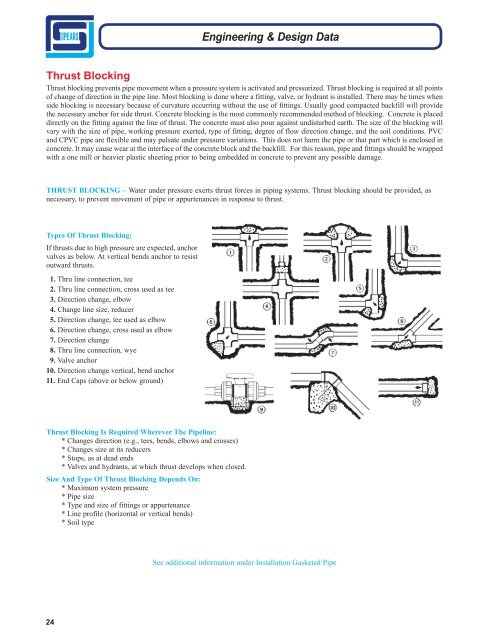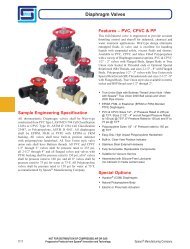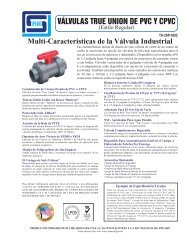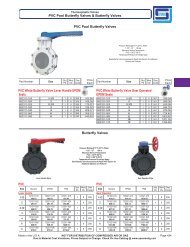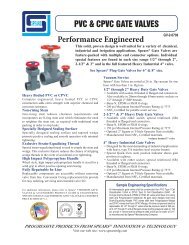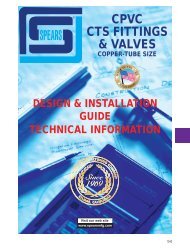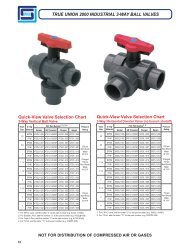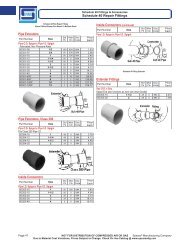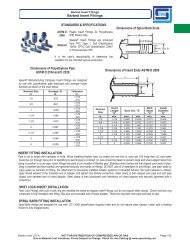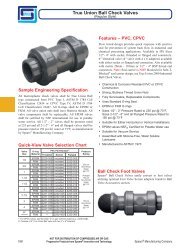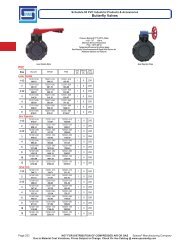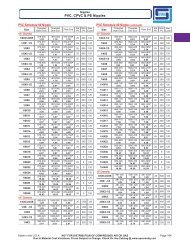If Preferred -- Download The Entire Booklet - Spears Manufacturing ...
If Preferred -- Download The Entire Booklet - Spears Manufacturing ...
If Preferred -- Download The Entire Booklet - Spears Manufacturing ...
Create successful ePaper yourself
Turn your PDF publications into a flip-book with our unique Google optimized e-Paper software.
Engineering & Design Data<br />
Thrust Blocking<br />
Thrust blocking prevents pipe movement when a pressure system is activated and pressurized. Thrust blocking is required at all points<br />
of change of direction in the pipe line. Most blocking is done where a fitting, valve, or hydrant is installed. <strong>The</strong>re may be times when<br />
side blocking is necessary because of curvature occurring without the use of fittings. Usually good compacted backfill will provide<br />
the necessary anchor for side thrust. Concrete blocking is the most commonly recommended method of blocking. Concrete is placed<br />
directly on the fitting against the line of thrust. <strong>The</strong> concrete must also pour against undisturbed earth. <strong>The</strong> size of the blocking will<br />
vary with the size of pipe, working pressure exerted, type of fitting, degree of flow direction change, and the soil conditions. PVC<br />
and CPVC pipe are flexible and may pulsate under pressure variations. This does not harm the pipe or that part which is enclosed in<br />
concrete. It may cause wear at the interface of the concrete block and the backfill. For this reason, pipe and fittings should be wrapped<br />
with a one mill or heavier plastic sheeting prior to being embedded in concrete to prevent any possible damage.<br />
THRUST BLOCKING – Water under pressure exerts thrust forces in piping systems. Thrust blocking should be provided, as<br />
necessary, to prevent movement of pipe or appurtenances in response to thrust.<br />
Types Of Thrust Blocking:<br />
<strong>If</strong> thrusts due to high pressure are expected, anchor<br />
valves as below. At vertical bends anchor to resist<br />
outward thrusts.<br />
1. Thru line connection, tee<br />
2. Thru line connection, cross used as tee<br />
3. Direction change, elbow<br />
4. Change line size, reducer<br />
5. Direction change, tee used as elbow<br />
6. Direction change, cross used as elbow<br />
7. Direction change<br />
8. Thru line connection, wye<br />
9. Valve anchor<br />
10. Direction change vertical, bend anchor<br />
11. End Caps (above or below ground)<br />
Thrust Blocking Is Required Wherever <strong>The</strong> Pipeline:<br />
* Changes direction (e.g., tees, bends, elbows and crosses)<br />
* Changes size at its reducers<br />
* Stops, as at dead ends<br />
* Valves and hydrants, at which thrust develops when closed.<br />
Size And Type Of Thrust Blocking Depends On:<br />
* Maximum system pressure<br />
* Pipe size<br />
* Type and size of fittings or appurtenance<br />
* Line profile (horizontal or vertical bends)<br />
* Soil type<br />
See additional information under Installation Gasketed Pipe<br />
24


